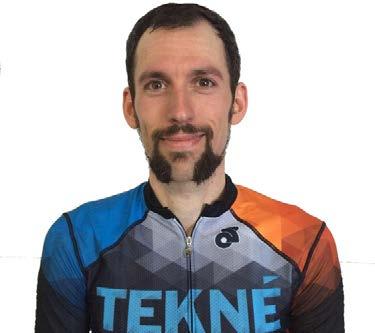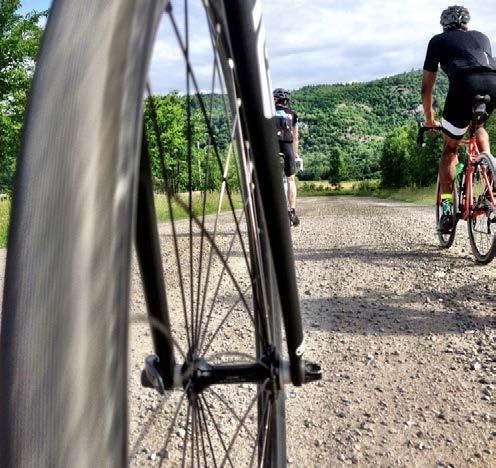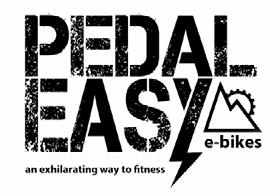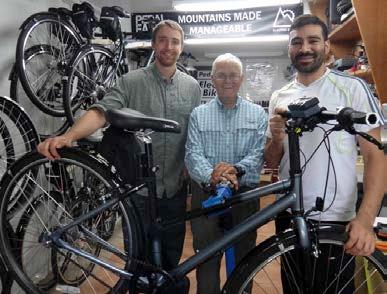
8 minute read
Gravel bikes circle back
GRAVEL BIKES CIRCLE BACK TO THE FUTURE ON ANY KIND OF ROAD
By Sheila Ascroft
Advertisement
Gravel bikes are made for cyclists who love their road bikes but want to get off the pavement. They meld mountain biking and cyclo-cross with long-distance riding on back roads and trails.
Gravel riding is not new, just a return to what cycling once was. A hundred years ago, all bikes were “gravel bikes,” since most roads were unpaved.
Think about how you rode just about anywhere on your bike as a kid. These bikes offer that same delightful go-anywhere option. Unlike the models of the past few decades with skinny tires that only handle smooth surfaces, gravel bikes have wide, sturdy rubber. Such tires can handle freshly graded gravel, rough chip seal, deep sand, ditches or pitches, muddy farm lanes or wooded trails covered with leaves. All you need is the handling skill to match the bike’s ability!
Gravel bikes look like road bikes with their lightweight frame and drop curve handlebar, but usually have a mountain bike’s cantilever or disc brakes to allow for the wider tires. They
Ottawa-Gatineau’s new Teknē Cycle Club enjoy mellow rides, the club’s purpose is to Wakefield, where everyone stops at is looking for members with spunk. to help cyclists improve themselves, and to the Pipolinka Bakery. The 100-kilometre
Its president, Matt Surch, 36, has raced practise cycling together,” Surch says. Cascades Loop, a short version of the mountain bikes, cyclo-cross and road bikes “Folks who are looking for a ‘race team’ Damned, crosses Wakefield’s covered for 22 years and has a clear view of the in order to progress in their ‘career’ and then bridge. Ride proceeds go to an as yet club’s shared culture. move along are not the sort of folks we are unnamed regional charity.
The club has “a diverse group of riders, looking for. We invite in cyclists who we’ve Another major club event is the Double from cadet to master, who share a passion come to know by doing the same sorts of Cross, an appetite catalyst hitting the for cycling and a common perspective riding, racing and events we do.” roads every Thanksgiving Monday, a on what matters: camaraderie, audacity, New members have to be nominated by rally/randonnée through Gatineau Park to generosity, and community. Many of us an existing member, endorsed by two other Wakefield and back. It’s open to all kinds of race, some of us don’t. We ride together. members, be approved by the board of ditrail-worthy bikes – cyclo-cross bikes with We support each other. We give back to the rectors and get past the club’s “no assholes” big tires, drop bar mountain bikes, regular community,” Surch says. policy. What this means is whether a promountain bikes, and even fat bikes are
So, what does “teknē” mean? spective member would find equivalent-skill all fair game. But the route is specifically
Surch calls it “embodied practice,” in club cyclists to ride with, and whether Teknē cyclo-cross-bike friendly, so it’s tame harmony with technology, an ancient Greek members would want to ride with them – for BIG tires. Featuring road, trail, and concept that blends art and theory. and whether they’d contribute to club events Pipolinka Bakery, it’s an 88-kilometre loop.
“Teknē permeates everything we do with and the cycling community. The Teknē Cycle Club is supported intention. It is mindfulness brought to how It costs $45 to join and club members by Giro Sport Design, Woven Precision we move our bodies in space. It is how we have to buy a club uniform kit, still under Handbuilts, Mad incorporate our tools – bikes – into our design. Alchemy, Brodie movement and expression. Teknē is pedalOn June 14, the club’s Ride of the Bikes, Greg ling because pedalling feels good. Teknē is Damned celebrates its seventh edition, an Cosgrove Design, knowing that there are many ways to pedal. event Surch organized for the Tall Tree Swiss Design Teknē is the embrace of the human drive Cycle Shop before he founded Teknē. Born Group and to strive, improve, refine, and share lessons out of a desire to share challenging routes Absolute Black. learned. Teknē is what makes cycling beauoff the beaten track, this ride emphasizes tiful and is why we ride.” adventure, not competition. It takes teams of
At the start of this year the club had about four to six riders north of Ottawa over roll35 members, all sharing this philosophy of ing hills and through rural Quebec, covering the bike, “people who want to have fun with paved and dirt roads far from traffic and cycling … whether you want to race or just big-city life. Matt Surch
Teknē Cycle Club wants The apex of the 155-kilometre route is the Paugan hydroelectric dam close cyclists with the right stuff to Low, Que. This massive structure tops a series of ascending dirt roads and provides a spectacular view of the Gatineau By Sheila Ascroft River. Beyond it, riders travel along lake shorelines and past farm fields and descend
also have a longer wheelbase and lower bottom bracket (for stability) than a typical roadie. It’s up to you whether to add fenders or get a face

full of mud. But beware: Front fenders can be risky on trails where sticks can kick up and lock the wheel.
Matt Surch, president of Teknē Cycle Club (previous page), says, “In the old days, tires were voluminous, clearance was ample, and body positions were more akin to that of a ride on a mountain bike of today than a road cyclist.”

Those ancient bikes took on all kinds of roads. But after the Second World War, Europe was rebuilding, and new, smooth paved roads made narrower tires an option. Racers, in contrast to cyclo-tourists, became obsessed with narrower tires, believing they were more efficient. Over time, these road bikes would only fit tires up to 23 millimetres wide. This resulted in a widespread move by recreational cyclists to the asphalt and to the ubiquitous 10-speed road bike. But few cyclists would ever ride the Tour de France, the governing myth behind that 10-speed technology.
Then came the mountain bike revolution and the emigration of cyclo-cross to America, and cyclists realized there was more to riding than just paved roads. Aging “roadies” want to dial down the hard-core pack riding of cycling clubs for something less regulated and more relaxed. Enter the gravel bike.
Surch says gravel bikes could be called simply “bicycles for riding.” They allow you to go almost anywhere at any time at any speed.

Some gravel events are for racers, others just for you and me who want to get away from urban distractions. Take one of the many rides in and around the Wakefield area and relish the old farmsteads, hidden valleys and the vistas of the Gatineau Hills – and little traffic. Nothing beats going down a new (old) road.
“It wasn’t until I started riding the dirt roads north of Ottawa that I realized how much I was missing,” says Surch, 36. “The terrain is beautiful. I’ve lived in Ottawa all my life, but had no idea what was in my back yard. It feels right to get to know my region better, and this is best done by bike. All I need are my fat tires, and I can ride wherever I want.”
Ottawa offers three April events ideal for gravel bikes. In the U.S., “gravel grinders” usually means hard, dusty, dirty races where riders have to grind out 200 kilometres. Our region’s oldest spring event is a little kinder, weather depending. The Ottawa Bicycle Club’s Almonte-Paris-Roubaix (April 12) takes its name from the Paris-Roubaix race that’s been around since 1896. They call it Enfer du Nord (Hell of the north) because of sections of rough pave or cobblestones, which can be brutal if it rains.
This cyclo-sportif event with its exciting forest sectors is preceded by Ride with Rendall’s Clarence-Rockland Classic on April 5 over a mostly flat route with gravel sectors and wind.

Later, on June 14, comes Teknē Cycle Club’s “Ride of the Damned” through Cantley, Low and Wakefield. Count on beautiful scenery, a fair bit of climbing, and the spectacular Paugan hydroelectric dam. For more details, check out www.teknecycling.com.
Surch says that unlike the past April 5 and 12 events, the Damned is “not a race. It exposes riders to the delights of riding unpaved roads, and the team format ensures riders’ support over what is a challenging route for most.”
THE “EQUALIZER BIKE” It brings mismatched cyclists together
Want to cycle with a partner but having trouble keeping up? No problem, even if your partner is an Olympic athlete.
The world’s lightest “hybrid” power-assisted bike and extremely simple in concept, discrete in appearance.
In feel and looks it is first and foremost a high-end bicycle.

It’s cycling re-born. It’s an experience almost beyond description; like that “bionic” moment in your youth when you first mastered a conventional bicycle.
Cycle more than you ever dreamed. It will “lure” you into fitness.
Contact us, we will bring a bike over for you to see and try … or visit our shop … we manufacture these right here in Ottawa. Many models to choose from. Prices start at $1650.

www.PedalEasy.ca
claudio@pedaleasy.ca
T. (613) 808 .8393









